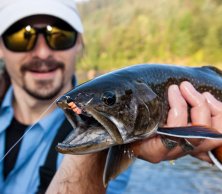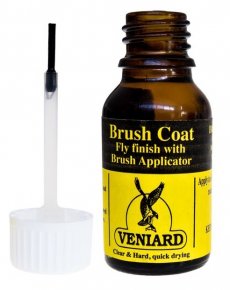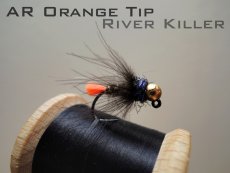Fly tying procedure of one of my variants of the very original type of floating streamer "AR Suspender Pin Fry Streamer" in the traditional and popular form "Step By Step" photo gallery with a detailed description of individual tying steps and materials!
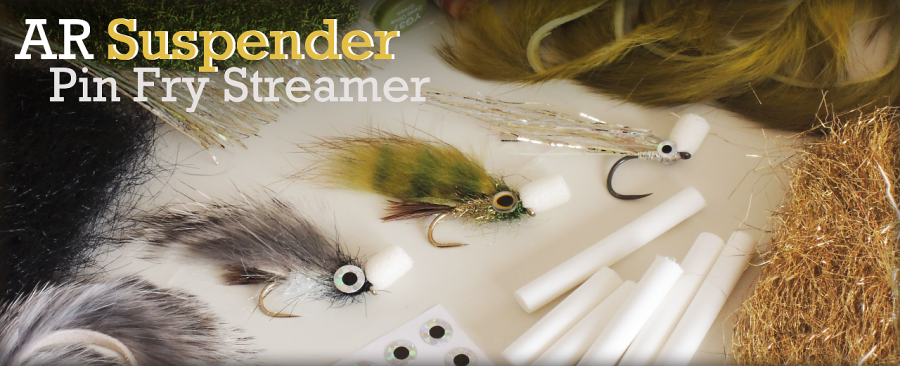
In the next part of my regular series "At The Vice", I have prepared for you the fly tying procedure of a smaller subsurface streamer "AR Suspender Pin Fry Streamer", which is very actual for this period of the ending summer and the slowly coming autumn! At this time, predatory fish are actively hunting mainly fry of a coarse fish, which congregate in larger shoals and are heated in shallow areas of reservoirs and lakes, or even in the calmer, warmer pools of larger rivers.
This type of "floating" streamer is especially very popular in the UK, where similar patterns are fished in this period of Indian summer for large lake rainbow trout and brown trout, who hunt fry of roaches and small perch or other small fish such as stickelbacks, etc. It is at this time that the greatest chance to catch the largest trout in the very clear water reservoirs, which in this magical time are called "Fry Feeders"!
Due to the very irritating fact that our Czech Fishing Association (Český rybářský svaz - ČRS) has so far been unable to do anything other than actively and - in terms of its economic mindset - evidently targeted destruction of the vast majority - hitherto historically existing - financially unpromising trout reservoirs by absolutely meaningless management of these types of waters, in which he gradually stocked fish species completely incompatible with the sustainability of salmonid fish stocks and at the same time with the quality and purity of water, we have no choice but to despair (I have long since given up hope) that we - enthusiastic stillwater fly fishers/trout fishermen - will probably never be able to regularly go fishing for large lake trout among other things fed on fry during this beautiful autumn fishing season.
For me personally, this fact is becoming more and more frustrating, especially when I realize how many suitable water reservoirs or very clean and lively gravel and sand pits would be available throughout the Czech Republic for the regular stocking of salmonid fish. However, the Council of the ČRS and most of the Czech fishing nation, after the eradication of our - at one time - most abundant fish species - salmon - very quickly found a poor meat substitute in the form of "Domestic Fish" = Carp, which is thoughtlessly stocked everywhere!
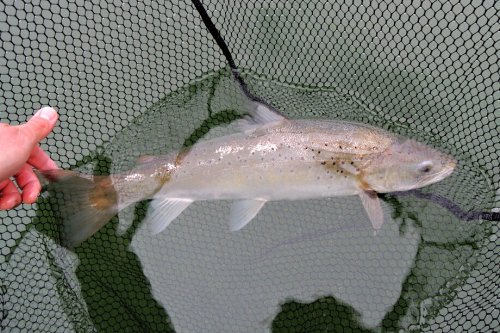
Personally, I am very surprised that, for example, that individual associations taking care of individual waters in the Czech regions, as lessors of state waters to ČRS, obviously do not think at all about the effects of often inappropriate management on their waters. It is in the already mentioned UK that it is quite common that the owner of this water - such as Anglian Waters - manages the reservoirs that serves as a source of drinking water and fishing. Who else should know best how strongly the fish stock will affect the quality and purity of water, which is then used as a drink? Therefore, everyone with common sense will immediately realize that predatory fish, which at the right balance function in the water as liquidators of sick fish, etc. + salmonid fish, which serve in the water as bioindicators mean a huge and unquestionable PLUS for overall water quality, compared to fish species whose behavior and "lifestyle" help globally only to degrade water quality... Not only in this problematic we still have to learn a lot, in any case it is already clear to me that none of what I would like and what I he critically outlined here, unfortunately I will not live to see it and I strongly doubt that the next generation of Czech stillwater fly fishermen did, even if I wished them wholeheartedly! :-(
The main use: Despite all the bitter and sad above, I tried to find the use of this type of streamer in our conditions. I do this whenever I like a "foreign" type of fly, but for example abroad it is used for a purpose that is unrealistic or very rarely feasible for some reason. The AR Suspender Pin Fry Streamer can be used with great efficiency, for example, in autumn fly fishing for perch - quite similar to the trout fishing described above on reservoirs in the UK. Therefore, try to fish the shallows of the dams, look for warm flock of small fish, or look for overgrown places, stone ramparts - hiding places for fish and predators and throw this streamer on a floating line near them. The ideal stripping of the streamer is medium-long pulls with longer pauses, which mimics an injured or frightened / confused fish, which is very attractive for lurking perch.
Another suitable way to use this fly is during summer river and lake fishing of actively hunting asp. In this case, stripping of the streamer must be extremely fast! Ideally, the asp behind our fly fires and at such a moment he should not have many opportunities to see through the scam! Therefore, look for active cruising asp, cast the streamer into their trajectory and immediately start a fast stripping for his quick impact. In larger sizes, this type of streamer is of course also suitable for pike or also for summer evening/night fishing for zander in the shallows.
I like so much this original concept of this type of streamer - the use of the idea of a floating head + an sunk body. In essence, it is a kind of "streamer shuttlecock / suspender", whose behavior in water is completely unique. This is not a Popper, Gurlgler or their equivalent. Poppers and Gurglers are baits primarily designed for aggressive surface irritation of large predatory fish. This type of streamer was developed primarily for the hunting of indigenous trout, which are usually not caught on surface streamers, it is already unique in that. Therefore, I would include this type of fly and the style of fishing with it in my imaginary list of "Endemic fly fishing techniques", which include, for example, fly fishing with large Terrestrials (NZ), specific summer targeted carp stalking, irritating wild rainbows with skating mouse imitation, which is very popular, for example, in Kamchatka, etc. In short, every fly-fishing region has its own fly-fishing manners and that's what it's beautiful about!
So let's tie this original type of semi-floating streamer together step by step with a detailed description of the individual operations and the used fly tying materials! ;-)
STEP 1: In the first step, we firmly attach a large Fly Tying Hook Fulling Mill Nymph Bronze BL in sizes 8 - 10 to the tying vice. I choose the type of hook depending on the specific pattern and its size. On other variants, which can be seen in the introductory photo, for example, I also used the Fly Tying Hook Fulling Mill Competition Heavyweight in size 6 (imitation of small perch) or a special type with a deep bend originally designed for tying carp flies Fly Tying Hook Fulling Mill Bonio Carp BL (small pin fry Sparkler). At the hook eye, wind the tying thread into the varnish base and attach the slightly rounded Polycelon tube Booby Eyes Hends in white color with a diameter of 5 - 6 mm. Make sure you tie the polycelon straight. Otherwise, the streamer does not have to float straight, it can rotate in the water in various ways when stripping it, etc. and that is inadmissible! The polycelon tube can be painted, for example, with water-resistant markers, or use a different color. But its main importance lies in its ability to keep the front of the streamer at the surface! Finally, fix the wraps with super glue so that the polycelon tube on the hook does not roll over.
STEP 2: In the next phase, we move the tying thread towards the hook bend and we attach a thicker tail from darker mottled feathers to the pre-painted base. Great feathers are from turkey or pheasant hen. It is possible to use thicker tail from cock feather. This part is not an look matter, but mainly an effective one. This feather will ensure that the fine hairs from the end of the zonker wing will hold over the arch of the hook and will not turn around. This factor then numbs the streamer and checking the bait after each cast just because you missed this step is very tiring and in cases where the zonker catches the hook bend, you are missing out on fish strikes!
STEP 3: In the next step, we firmly attach the silver Color Wire Hends 0,14 mm to the hook, or also otherwise colored ribbing wire. The main role of this wire is to fix the zonker strip to the body. Therefore, choose a wire that is strong enough so that it does not break. In this case, the graveyard protrudes from the body and the fly is not as effective. The wire also fulfills the load function here, as this type of streamer should float mainly through the head part at the surface and the rest of the body should be sunk. Such a streamer in the water perfectly imitates a small fish, which, for example, eats something from the surface in a shoal of other fish, or she is somehow injured, stunned or confused and is gasping for air. And predators like to choose fish with handicapped in this way!
STEP 4: In the fourth step we create a conical body from the fine synthetic UV-ICE Dubbing Hends white pearl color. Then we comb the body with Velcro. When imitating a fish fry or a very small fish, I like to choose these inconspicuous transparent colors. In this case, I do not even change the black tying thread, for example, for a light shade, because the dark thread shines through a transparent body after soaking, which is very attractive and closer to nature than if we tried a perfect "catalog pattern", which is then unchanged in water and for fish unattractive - dead.
STEP 5: At this stage, we will tie a short Zonker Strips Hends Muskrat 1,5 mm in the area behind the erected polycelon roller in a gray mottled color, or it is possible to use a finer alternative to rabbit fur or zonker from an American squirrel, etc. Such a graveyard beautifully imitates the moving body of a small fish. When attracting a bait that clears the water surface, the fur retracts into a narrow fish silhouette, after stopping, on the contrary, it pulsates beautifully and imitates the play of muscles and scales of a small fish.
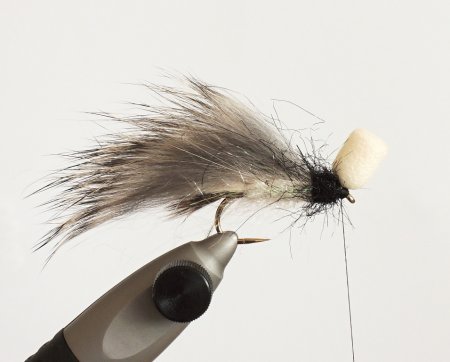
STEP 6: In the penultimate step, we will ribbing the body and at the same time fix the zonker strip to it. Tighten the wraps, because after soaking the fly, the material will always come loose a little. When ribbing the wire over the zonker strip, always spread the fine hair with a dubbing needle so that the wire does not fix it to the body most of the time. We need a moving hair mainly in water, not fixed on the fly! ;-) After finishing the ribbing, fix the wire with a few turns of thread and cut off the rest. We add a larger black head from Metalic Dubbing Hends to the painted space between the ridge and the polycelon and we comb the whole fly - the body, the back and the head - strongly with Velcro and cut the long fibers with scissors!
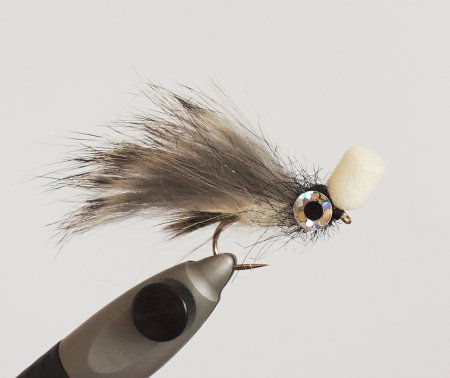
STEP 7: In the final step, we finish the fly with a few lost knots between the hook eye and the polycelon tube, we paint this fix well with varnish and prepare the fly for gluing Holographic Eyes Hends. I always thoroughly comb my head with Velcro once more and press it firmly in the tweezers to create a kind of surface for better eyes gluing. I drip a second glue on each eye, which I hold by the edge in the tweezers, and gently apply it to the chosen place. As soon as I'm sure of the location, I press the eyelet firmly against the head with a flat part of tweezers. Once one eye is glued and held firmly, I glue the other. In the end, the final control is enough, perhaps an additional combing of dubbing between the eyes with a dubbing needle and the AR Suspender Pin Fry Streamer is ready to be cast among a shoal of hunting fish predators! ;-)
CONCLUSION: Although this my today article has a little bitter taste of unfulfilled dreams from untapped potentials due to critical reflection in the introduction, I hope that you will try to follow this original pattern again with the help of my procedure and then try it in autumn fishing of beautifully colored perch, wild trout, or it will last you until the summer, where you will chase with it silver knights of heated shoals and river currents - asp! Don't be afraid to try even more size and color variants and adapt your pattern to the fish crumb at the location you are visiting - this is the only way to get as close as possible to your future fish opponent!
If the readers of my articles include those who, after all, have the exceptional opportunity to fish for wild stillwater rainbow and brown fry feeders in one of the many foreign water reservoirs, enjoy this beautiful privilege and especially appreciate the fact, because as it goes in life - we really appreciate a lot of things often only when we lose them!
I wish all passionate fly fishermen a lot of success and beautiful catches during autumn fishing trips! ;-) Aleš







